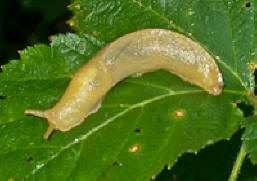 Like their cousins,
slugs, snails are members of a group of animals called
mollusks along with oysters and clams. The big
difference is that snails have a protective shell to
protect their bodies. Both snails and slugs navigate
around your plants on a slime trail made of mucus they
secrete so that they wont dry out.
Like their cousins,
slugs, snails are members of a group of animals called
mollusks along with oysters and clams. The big
difference is that snails have a protective shell to
protect their bodies. Both snails and slugs navigate
around your plants on a slime trail made of mucus they
secrete so that they wont dry out.
Since they need a healthy
supply of moisture at all times, you will find them in
wet, often shady parts of the garden. They lay their
eggs in decomposing mulch or leaf debris and under
rocks.
Snails feed on live plant
tissue or on decomposing organic matter in the garden.



